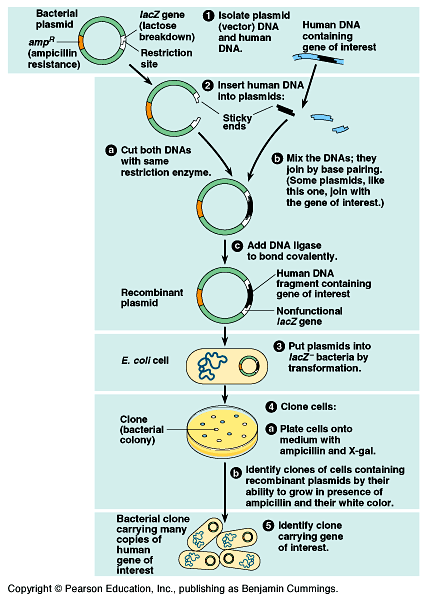
Gene cloning- Steps involved in gene cloning
Gene cloning
- Gene cloning involves separation of specific gene or DNA fragments from a donor cell, attaching it to small carrier molecule called vector and then replicating this recombinant vector into a host cell.
Steps involved in gene cloning
- Isolation of donor DNA fragment or gene
- Selection of suitable vector
- Incorporation of donor DNA fragment into the vector
- Transformation of recombinant vector into a suitable host cell
- Isolation of recombinant host cell

1. Isolation of donor DNA fragment or gene
- At first a donor DNA fragment should be isolated. There are two method for isolation of desired gene or DNA fragment.
- Using restriction endonuclease enzyme: the enzyme restriction endonuclease is a key enzyme in molecular gene cloning. It has specific restriction site for its action. The enzyme RE generates a DNA fragment either with blunt end or with sticky end
- Using reverse transcriptase enzyme: reverse transcriptase enzyme Synthesizes complementary DNA strand of the desired gene using its mRNA.
2. Selection of suitable cloning vector:
- When donor DNA fragment is incorporated into a host cell, it will not replicates because the isolated gene do not have the capacity to replicated itself. So before introduction of donor fragment into host, a suitable vector should be selected.
- Cloning vector is the DNA molecule capable of self-replication inside the host cell. the main function of cloning vector is to replicates the inserted DNA fragment inside the host cell.
- Examples of cloning vectors: Plasmid, BAC, YAC, Λ-bacteriophase, expression vectors etc.
Characteristics of a cloning vectors
- It must be self-replicating inside host cell
- It must possess restriction site for RE enzymes
- Introduction of donor DNA fragment must not interfere with replication property of the vector
- It must possess some marker gene such that it can be used for later identification of recombinant cell.
3. Incorporation of donor DNA fragment with Plasmid vector:
- The plasmid vector is cut open by the same RE enzyme used for isolation of donor DNA fragment
- The mixture of donor DNA fragment and plasmid vector are mixed together.
- In the presence of DNA ligase, base pairing of donor DNA fragment and plasmid vector occurs forming recombinant vector in the mixture
4. Transformation of recombinant vector into suitable host:
- The recombinant vector is transformed into suitable host cell. ie bacterial cell
- Some bacteria are naturally transformable, they take up the recombinant vector automatically. For examples: Bacillus, Haemophillus, Helicobacter pylori, are naturally competent
- Some other bacteria are not naturally competent, in those bacteria recombinant vector are incorporated by artificial method such as Ca++ ion treatment, electroporation etc
5. Isolation of recombinant cell:
- The recombinant host cell is then grown in culture media but the culture may contains colonies both recombinant cell and non-recombinant cell.
- For isolation of recombinant cell from non-recombinant cell, marker gene of plasmid vector is employed.
- For examples, PBR322 plasmid vector contains different marker gene (Ampicillin resistant gene and Tetracycline resistant gene. When pst1 RE is used it knock out Ampicillin resistant gene from the plasmid, so that the recombinant cell become sensitive to Ampicillin.
References
- http://home.earthlink.net/~dayvdanls/gene_cloning.htm
- http://www.unc.edu/depts/our/hhmi/hhmi-ft_learning_modules/proteinsmodule/cloning/process.html
- http://www.unc.edu/depts/our/hhmi/hhmi-ft_learning_modules/proteinsmodule/cloning/process.html
- http://sivabio.50webs.com/dnacloning.htm
- https://www.khanacademy.org/science/biology/biotech-dna-technology/dna-cloning-tutorial/a/overview-dna-cloning
